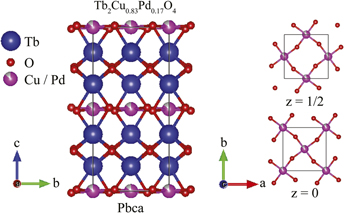Article contents
Stabilizing the Tb-based 214 cuprate by partial Pd substitution
Published online by Cambridge University Press: 15 May 2018
Abstract

Previously known to form only under high pressure synthetic conditions, here we report that the T′-type 214-structure cuprate based on the rare earth atom Tb is stabilized for ambient pressure synthesis through partial substitution of Pd for Cu. The new material is obtained in purest form for mixtures of nominal composition Tb1.96Cu0.8Pd0.2O4. The refined formula, in orthorhombic space group Pbca, with a = 5.5117(1) Å, b = 5.5088(1) Å, and c = 11.8818(1) Å, is Tb2Cu0.83Pd0.17O4. An incommensurate structural modulation is seen along the a axis by electron diffraction and high resolution imaging. Magnetic susceptibility measurements reveal long-range antiferromagnetic ordering at 7.9 K, with a less pronounced feature at 95 K; a magnetic moment reorientation transition is observed to onset at a field of approximately 1.1 T at 3 K. The material is an n-type semiconductor.
- Type
- Article
- Information
- Copyright
- Copyright © Materials Research Society 2018
References
REFERENCES
- 4
- Cited by



